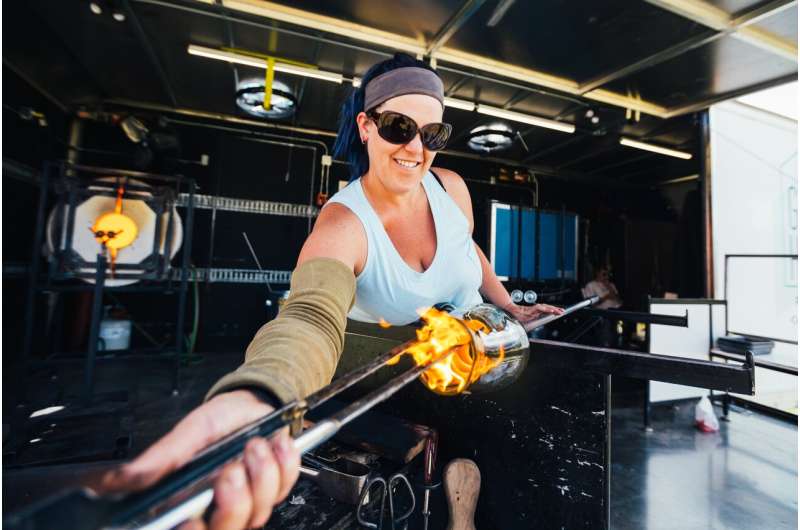This article has been reviewed according to Science X's editorial process and policies. Editors have highlighted the following attributes while ensuring the content's credibility:
fact-checked
trusted source
proofread
Why making things matters to Australia's future

Australia's ability to sustain its local manufacturing industry is under threat by a generational loss of crafts and hands-on making expertise.
This threat is compounded by some manufacturers moving operations offshore over the last four decades, causing a slow decline in practical making skills and loss of knowledge.
University of South Australia Professor of Culture and Creative Industries and Director of the Creative People, Products and Places Research Center, Susan Luckman, says craft skills in Australian employment have been declining since 2006 despite the overall economy continuing to grow.
"The biggest threat to Australia's making economy is its aging workforce. Australia benefited hugely from trade-skills migration in the decades following WW2 and up until the 1980s we had a strong domestic manufacturing sector," she says.
"Subsequent offshoring of manufacturing has meant that craft skills have not been sustained and replenished in the Australian workforce. However, according to data drawn from the last Australian Census, those skilled makers still working in this dwindling workforce are enjoying increasing incomes as advanced manufacturing, the artisanal economy, and demand for Australian-made goods all grow."
While the last Holden car rolling off the assembly line in Elizabeth, South Australia, marked a significant loss to the country's manufacturing industry in 2017, other iconic Aussie brands that have met similar fates include clothing brands Bonds, King Gee, Hard Yakka, Speedo and, most recently, white paper company Reflex.
The domestic manufacturing industry's freefall is despite more than 116,500 people—or 1.1% of the total workforce—being employed in the sector in 2021 and contributing $19.2 billion to gross domestic product. This is slightly larger than the country's sports economy, which supported 128,000 jobs in 2016–17, but contributed $14.5 billion.
Prof. Luckman says these figures prove the high value of Australia's craft and manufacturing industry, which enables both niche and mass production of everything from small scale, high-end custom bicycles to large scale textile manufacturing.
"Scalable production enabled by digital tools operating alongside skilled craftspeople offers exciting potential for a renaissance of Australian making, especially through SMEs who constitute most of Australia's contemporary manufacturing ecosystem."
Prof. Luckman has been researching the value of craft skills to the future of making in the country as part of a research project funded by the Australian Research Council.
Over the last four years, she has conducted almost 50 interviews with people from craft and manufacturing organizations as well as sole traders around the country. Participants, which included shoemakers, potters, sail makers, and sculptors, shared their insights into education and training, industry challenges and opportunities for future innovation.
Prof. Luckman says we must learn to embrace technology and that the worlds of tradition and digital innovation must collide.
"We are seeing manual skills and digital skills as separate spheres, and this is a problem. Digital technologies can revolutionize advanced manufacturing by re-imagining our processes of production and turnover," she says.
"If we want to rebuild our domestic manufacturing capacity, we need renewed support for hands-on craft skills training, and we need to be supporting greater collaboration with industry alongside the roll-out of digital technology."
South Australian not-profit-profit organization JamFactory has been championing the social, cultural and economic value of craft and design for the last 50 years.
Employing about 50 craftspeople in a variety of roles from assisting with production to teaching short courses, JamFactory also attracts artisans who access the facilities—particularly the glassblowing studio—to make their wares.
JamFactory CEO Brian Parkes says increased interest in hand-made or locally produced goods, along with the exposure of crafts and craft-based businesses through social media, has seen an increase in young people considering creative entrepreneurship careers.
"We're seeing more interest from young people wanting to learn craft skills through skills-based workshops but we're seeing graduates emerge from tertiary education with significantly less technical skills than even a decade ago," he says.
"In glassblowing for example, we're seeing a rapidly growing demand for manufacturing services through facilities like JamFactory and the Canberra Glassworks. These facilities have been shaped around artisanal production, following the demise of industrial factory glassblowing in Australia half a century ago, but are generating significant employment for skilled glassblowers through the opportunities in manufacturing.
"The problem is that there simply aren't enough people with sufficient skills, and there is no clear training pathway to develop these skills outside of a general contemporary art degree. We need to look at mentorships, traineeships, and even skilled migration to address the problem in the short to medium term."
More information: The value of craft skills to the future of making in Australia. apo.org.au/node/324171
Provided by University of South Australia


















